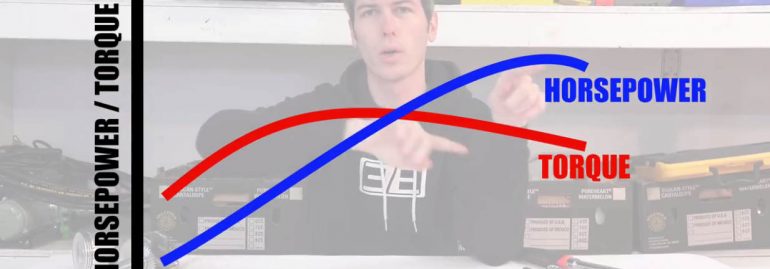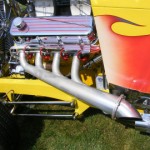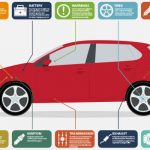Transcript:
Hello everyone and welcome. In this video we’re going to be talking about the difference between torque and horsepower.
And we’re not going to be using any strange analogies and very minimal math; just talking about theory and keeping it easy to understand. So we’ll start things off with torque. Torque is simply a force applied at a distance.
You can think of it as a twisting force. So if you’re trying to tighten something down using a wrench, You apply a force, you press down at a distance, the length of that wrench, and that supplies a torque at whatever you’re tightening. Same idea with a socket wrench.
So if you’re tightening down a bolt you apply a force at a distance, And that supplies a torque to that bolt to fasten down that bolt.
Now the same thing is happening with your engine. So combustion within your cylinder is what’s supplying the force pressing this piston down, and then that piston is pressing down on a crankshaft.
So as you can see, you’ve got your force pressing down…
You’ve got your distance where it’s pressing on the crankshaft, the axis of rotation is the center here the piston is pressing offset from that center so at a specific distance and Combined that gives you your engine torque, force pressing down at a specific distance that gives you a twisting force.
That’s the torque that your engine is making now torque can be manipulated very easily By using gears or by using leverage for example.
So this will supply you know with the maximum amount of force I can supply to it a certain amount of torque.
But then if I were to use something much longer Now I have more leverage I can press at a greater distance and since torque is force multiplied by distance The torque here is going to be significantly greater Okay, so what is power and how do these two relate?
Well, power is the rate at which work is done. So what does that mean? Well if I move this car from here to here. I’ve done a certain amount of work I’ve moved this from here to here, now if I do it very slowly it doesn’t require much power. if I do it very quickly it requires more power Now ultimately I’m accomplishing the same thing I’m moving the car from here to here, but I’m doing it faster.
The rate of work is greater therefore It takes more power so more power going quickly than going slowly So power ultimately is what gives you speed, what gives you acceleration now the two are connected so in in our context Here looking at our engine.
We have torque as a force pressing down acting at a distance Well how fast that’s happening is our power so that’s our rpm. So horsepower is torque multiplied by rpm. So how often this interaction is occurring…
And so how fast is this spinning while we’re still getting that consistent force acting on the piston so the faster it spins Supplying that same amount of force at that same distance the more power we’re going to make Okay, so how about an example to help explain things further?
Let’s say we have two different vehicles that are exactly the same.
Now, I know these look different, but we’re just going to pretend They’re exactly the same nothing about them is different except this one has 200 horsepower and a hundred pound feet of torque Those are the peak numbers.
This one has 200 pound feet of torque and a hundred horsepower so half the power Twice the torque this one has twice the power half the torque Which one is going to accelerate faster assuming both of them have the same mass? And everything else about them is equal Well the one with more power is always going to be quicker because that is the rate at which work is done.
That’s how quickly it can accomplish work move something from one place to another it can move it faster Now this one has more torque, great But as we know torque can be manipulated through gearing so gears act just like leverage.
So while this doesn’t have as much torque as this If I’m applying torque to something I – my power doesn’t change, how strong I am doesn’t change.
But I can use leverage just like cars can use gears to make more torque so this car with twice the power But half the torque can use gears to accelerate faster.
So it can use a longer You know leverage arm a greater a more aggressive gear ratio, So that it can put that power down and ultimately because it makes more power it can do more work more quickly It will be the faster car.
Okay so now let’s talk about horsepower and torque curves because when a manufacturer gives you a horsepower and a torque figure.
They’re just giving you the peak figure for each of those. They’re not giving you, you know the amount of torque that that produces across all of the engine rpm range.
And so if you look at a torque curve, it’ll have some peak along that curve with respect to rpm so that’s the engine rpm in which the force pressing down on the piston is at its greatest so that’s peak torque and what that means if you stay within a set gear…
… if you’re in one gear let’s say you’re in third gear, you will feel the – the force pressing you against your seat will be the greatest at peak torque now.
That’s assuming you’re staying at a constant gear ratio You’re staying within one gear So now if you look at the horse power curve overlaid over that torque curve At some point, peak horsepower will occur.
And that’s when the engine is doing the most amount of work it can do and so at this point You may think okay if I want to accelerate fastest I need to be at peak torque, so you want to be at that peak spot Well, that’s only true for a set gear and that’s only within that gear if you can manipulate the gear ratio Let’s say peak torque is right here
But peak power is over here, later in the RPM range you can sacrifice torque But get a more aggressive gear ratio, and ultimately accelerate more quickly by accelerating at peak power So why is that well that’s because you’re multiplying your torque by the gear ratio
So you have peak torque multiplied by a lower gear ratio versus a lower torque
But multiplied by a significantly higher gear ratio at peak horsepower That will give you your peak acceleration.
So for example CVT transmissions Which can adjust the gear ratio constantly If they adjust that gear ratio to maintain the engine at peak horsepower
They will accelerate the fastest rather than if you were to manually shift gears, or have an automatic transmission Which shifts between gears and you’ll feel that peak sensation that peak force against the seat at peak torque as you cross over it, but the actual true amount of peak acceleration.
That’s possible with that engine would be if you manipulated gearing if you Manipulated leverage to allow you to be at the highest horsepower Level with the most aggressive gear ratio possible so a quick review, torque is simply a force acting at a distance Horsepower is how quickly you can accomplish work, now both of them require each other.
They’re a function of each other horsepower is torque multiplied by rpm, so you’ve got a specific torque and then you spin the engine at a certain speed, that will give you power.
And so ultimately they are you know they require one another you can’t have horsepower without torque But the most important figure if you’re looking at “how fast will a car be able to accelerate?” “What will its top speed be?” that comes down to power because that’s telling you how quickly?
Can you accomplish a certain amount of work. So hopefully this has cleared things up; the differences between torque and horsepower If you have any questions or comments, feel free to leave them below.






